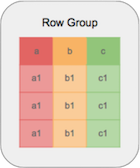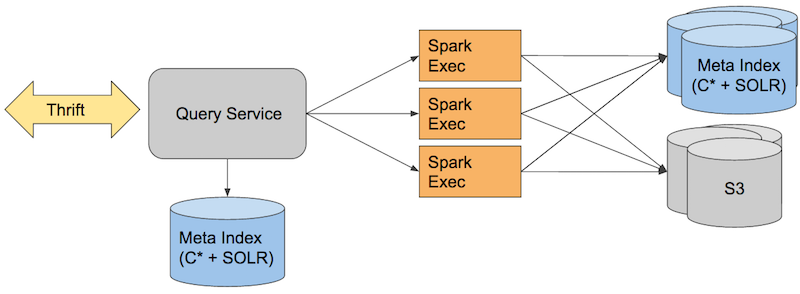class: center, middle, inverse # Cold Storage that isn’t glacial ##### Joshua Hollander, Principal Software Engineer ###  ProtectWise --- class: inverse # Who are we and what do we do? -- ### We record full fidelity Network Data -- * Every network conversation (NetFlow) -- * Full fidelity packet data (PCAP) -- * Searchable detailed protocol data for: * HTTP * DNS * DHCP * Files * Security Events (IDS) * and more... -- ### We analyze all that data and detect threats others can't see --- # Network data piles up fast! -- * Over 300 C* servers in production * Over 1200 servers in EC2 * Over 150TB in C* * About 90TB of SOLR indexes * 100TB of cold storage data * 2 PB of PCAP -- ### And we are growing rapidly! --- class: center, middle, inverse # So what? -- ### All those servers cost a lot of money --- # Right sizing our AWS bill -- ### This is all time series data: * Lots of writes/reads to recent data * Some reads and very few writes to older data -- ### So just move all that older, *cold data*, to cheaper storage. > How hard could that possibly be? --- # Problem 1: #### Data distributed evenly across all these expensive servers * Using Size Tiered Compaction * Can't just migrate old SSTables to new cheap servers -- #### Solution: use Date Tiered Compaction? * We update old data regularly * What SSTables can you safely migrate? #### Result: -- .center[] --- # Problem 2: DSE/SOLR re-index takes *forever*! #### We have nodes with up to 300GB of SOLR indexes * Bootstraping a new node requires re-index after streaming * Re-index can take a ***week or more***!!! * At that pace we simply cannot bootstrap new nodes -- #### Solution: * Time sharded clusters in application code * Fanout searches for large time windows * Assemble results in code (using same algorithm SOLR does) -- #### Result: .big[ `¯\_(ツ)_/¯` ] --- # What did we gain? -- ## We can now migrate older timeshards to cheaper servers! -- ## However: * Cold data servers are still too expensive * DevOps time suck is massive * Product wants us to store even more data! --- # Throwing ideas at the wall -- ### We have this giant data warehouse, let's use that * Response time is too slow: 10 seconds to pull single record by ID! * Complex ETL pipeline where latency measured in hours * Data model is different * Read only * Reliability, etc, etc -- ### What about Elastic Search, HBase, Hive/Parquet, MongoDB, etc, etc? -- ### Wait. Hold on! This Parquet thing is interesting... --- # Parquet -- ### Columnar * Projections are very efficient * Enables vectorized execution -- ### Compressed * Repeated values become cheap * Using Run Length Encoding * Throw Snappy, LZO, or LZ4 on top of that -- ### Schema * Files encode schema and other meta-data * Support exists for merging disparate schema amongst files --- # Parquet: Some details .left-column.parquet[ .center[] .center[] ] .right-column[ #### Row Group * Within each row group data is arranged by column in chunks * One chunk for each column in the data set #### Column Chunk * Chunk of data for an individual column * Column chunks are sub-divided into pages for compression and encoding #### Page * Column chunks are divided up into pages for I/O ] --- class: center, middle, inverse # So you have a nice file format... # Now what? --- class: center, middle ## Need to get data out of Cassandra -- > Spark seems good for that -- ## Need to put the data somewhere -- > S3 is really cheap and fairly well supported by Spark -- ## Need to be able to query the data -- > Spark seems good for that too --- class: center, middle, inverse # So we are using Spark and S3... # Now what? --- # Lots and lots of files ### Sizing parquet -- * Parquet docs recommend 1GB files for HDFS -- * For S3 the sweet spot appears to be 128 to 256MB -- ### We have terabytes of files ### Scans take *forever*! -- .center[] --- # Partitioning #### Our queries are always filtered by: 1. Customer 2. Time -- #### So we Partition by: ``` ├── cid=X | ├── year=2015 | └── year=2016 | └── month=0 | └── day=0 | └── hour=0 └── cid=Y ``` -- ### Spark understands and translates query filters to this folder structure --- class: center, middle, inverse # Big Improvement! ### Now a customer can query a time range quickly --- class: center # Partitioning problems -- ### Customers generally ask questions such as: > "Over the last 6 months, how many times did I see IP X using protocol Y?" -- > "When did IP X not use port 80 for HTTP?" -- > "Who keeps scanning server Z for open SSH ports?" -- ### Queries would take minutes. --- # Queries spanning large time windows ```sql select count(*) from events where ip = '192.168.0.1' and cid = 1 and year = 2016 ``` -- ``` ├── cid=X | ├── year=2015 | └── year=2016 | |── month=0 | | └── day=0 | | └── hour=0 | | └── 192.168.0.1_was_NOT_here.parquet | └── month=1 | └── day=0 | └── hour=0 | └── 192.168.0.1_WAS_HERE.parquet └── cid=Y ``` --- # Problem #1 * Requires listing out all the sub-dirs for large time ranges. * Remember S3 is not really a file system * **Slow!** -- # Problem #2 * Pulling potentially thousands of files from S3. * **Slow and Costly!** --- # Solving problem #1 ### Put partition info and file listings in a db ala Hive. -- ### Why not just use Hive? -- * Still not fast enough * Also does not help with Problem #2 --- # DSE/SOLR to the Rescue! -- ### Store file meta data in SOLR -- ### Efficiently skip elements of partition hierarchy! ```sql select count(*) from events where month = 6 ``` -- ### Avoids pulling all meta in Spark driver 1. Get partition counts and schema info from SOLR driver-side 2. Submit SOLR RDD to cluster 3. Run `mapPartitions` on SOLR RDD and turn into Parquet RDDs > As an optimization for small file sets we pull the SOLR rows driver side --- class: middle .center[#Boxitecture  ] --- class: center, middle #Performance gains! .center[ Source | Scan/Filter Time ---------- | ----------------- SOLR | < 100 milliseconds Hive | > 5 seconds S3 directory listing | > 5 ***minutes!!!*** ] --- class: center, middle, inverse # Problem #1 Solved! -- ### What about Problem #2? --- # Solving problem #2 ### Still need to pull potentially thousands of files to answer our query! -- ### Can we partition differently? -- Field | Cardinality | Result ------------- | ------------- | -------------- Protocol | Medium (9000) | .center[❌] Port | High (65535) | .center[❌❌] IP Addresses | Astronomically High (3.4 undecillion) | .center[❌❌❌] .center[ ### Nope! Nope! Nope! ] --- # Searching High Cardinality Data -- ## Assumptions 1. Want to reduce # of files pulled for a given query 2. Cannot store all exact values in SOLR 3. We are okay with a few __false positives__ -- ### This sounds like a job for... --- class: center, middle # Bloom Filters!  --- # Towards a "Searchable" Bloom Filter -- ### Normal SOLR index looks vaguely like .medium[ Term | Doc IDs ------------|-------------- 192.168.0.1 | 1,2,3,5,8,13... 10.0.0.1 | 2,4,6,8... 8.8.8.8 | 1,2,3,4,5,6 ] -- ### Terms are going to grow out of control -- ### If only we could constrain to a reasonable number of values? --- # Terms as a "bloom filter" -- .center[] -- What if our terms were the __*offsets*__ of the Bloom Filter values? -- Term | Doc IDs -------|-------------- 0 | 1,2,3,5,8,13... 1 | 2,4,6,8... 2 | 1,2,3,4,5,6 3 | 1,2,3 ... | ... N | 1,2,3,4,5... --- # Searchable Bloom Filters .left-column.medium[ ### Index Term | Doc IDs -------|-------------- 0 | 0,1,2 1 | 1,2 2 | 1 3 | 0 4 | 1,2 5 | 0 ] .right-column.medium[ ### Indexing Field | Value | Indexed Values | Doc ID ---|-------------------|---------|----- ip | 192.168.0.1 | {0, 3, 5} | 0 ip | 10.0.0.1 | {1, 2, 4} | 1 ip | 8.8.8.8 | {0, 1, 4} | 2 ### Queries Field | Query String | Actual Query ---|-----------------|--------- ip | ip:192.168.0.1 | ip_bits:0 AND 3 AND 5 ip | ip:10.0.0.1 | ip_bits:1 AND 4 AND 5 ] --- class: center, middle, inverse # Problem #2 Solved! -- ### Enormous filtering power -- ### Relatively minimal cost in space and computation --- # Key Lookups -- #### Need to retain this C* functionality -- #### Spark/Parquet has no direct support > What partition would it choose? > The partition would have to be encoded in the key?! .big[🤔] -- #### Solution: * Our keys have time encoded in them * Enables us to generate the partition path containing the row -- .center[ ## That was easy! ] --- # Other reasons to "customize" -- ### Parquet has support for filter pushdown -- ### Spark has support for Parquet filter pushdown, but... -- * Uses INT96 for Timestamp * No pushdown support: [SPARK-11784](https://issues.apache.org/jira/browse/SPARK-11784) * All our queries involve timestamps! -- * IP Addresses * Spark, Impala, Presto have no direct support * Use string or binary * Wanted to be able to push down CIDR range comparisons -- ### Lack of pushdown for these leads to wasted I/O and GC pressure. --- # Archiving -- ### Currently, when Time shard fills up: 1. Roll new hot time shard 2. Run Spark job to Archive data to S3 3. ~~Swap out "warm" shard for cold storage~~ (automagical) 4. Drop the "warm" shard -- ### Not an ideal process, but deals with legacy requirements -- ### TODO: 1. Stream data straight to cold storage 2. Materialize customer edits in to hot storage 3. ~~Merge hot and cold data at query time~~ (already done) --- # What have we done so far? -- 1. Time sharded C* clusters with SOLR -- 2. Cheap speedy Cold storage based on S3 and Spark -- 3. A mechanism for archiving data to S3 --- # That's cool, but... -- ### How do we handle queries to 3 different stores? * C* * SOLR * Spark -- ### Handle Timesharding and Functional Sharding? -- --- # Lot's of Scala query DSL libraries: * Quill * Slick * Phantom * etc -- .center[ # AFAIK nobody supports: ] 1. Simultaneously querying heterogeneous data stores -- 2. Stitching together time series data from multiple stores -- 3. Managing sharding: * Configuration * Discovery --- # Enter Quaero: -- ### Abstracts away data store differences * Query AST (Algebraic Data Type in Scala) * Command/Strategy pattern for easily plugging in new data stores -- ### Deep understanding of sharding patterns * Handles merging of time/functional sharded data * Adding shards is configuration driven -- ### Exposes a "typesafe" query DSL similar to Phantom or Rogue * Reduce/eliminate bespoke code for retrieving the same data from all 3 stores --- class: center, middle, inverse # Open Sourcing? Maybe!? ### There is still a lot of work to be done --- class: center, middle, inverse # We are hiring! > Interwebs: [Careers @ Protectwise](https://www.protectwise.com/careers.html) > Twitter: [@ProtectWise](https://twitter.com/ProtectWise)